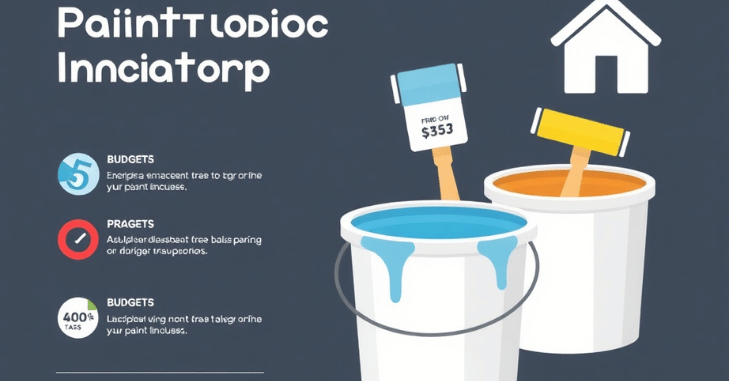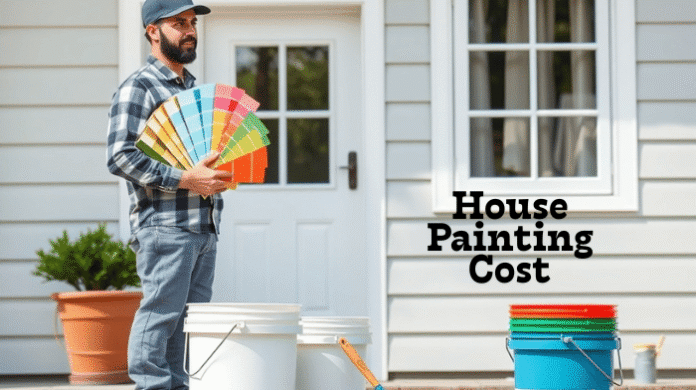Table of Contents
House Painting
Painting your house is one of the simplest and most effective ways to enhance its appearance, increase curb appeal, and protect it from environmental damage. Whether you are renovating, preparing to sell, or simply refreshing your home, understanding House Painting Cost is essential for proper budgeting and planning. A well-executed paint job not only transforms the look of your property but also safeguards it from sun damage, moisture, mold, mildew, and even termite damage on wooden surfaces.
In this comprehensive guide, we cover everything homeowners need to know about House Painting Cost, including cost breakdowns, design ideas, trending exterior and interior colors, and professional painting services, helping you achieve a long-lasting, attractive, and cost-effective finish.
Table: House Painting Cost and Key Details
| Category | Details / Examples |
| House Painting Cost (Interior) | Small (up to 1,000 sq ft): $1,000 – $2,500Medium (1,000 – 2,000 sq ft): $2,500 – $4,500Large (2,000 – 3,500 sq ft): $4,500 – $7,500Multi-story: $7,500 – $12,000Costs include paint, labor, and surface preparation. |
| House Size & Average Cost (Exterior) | Small (up to 1,000 sq ft): $1,500 – $3,500Medium (1,000 – 2,000 sq ft): $3,500 – $6,500Large (2,000 – 3,500 sq ft): $6,500 – $10,000Multi-story: $10,000 – $18,000Exterior costs are higher due to weatherproofing and prep work. |
| Factors Affecting Cost | House size, paint type, surface preparation, labor, design complexity, number of coats, and accessibility. Proper planning reduces unexpected expenses. |
| DIY Painting Pros | Lower cost (pay only for materials), personal satisfaction, and complete creative control. Ideal for small projects or budget-conscious homeowners. |
| DIY Painting Cons | Time-consuming, risk of mistakes, safety concerns (ladders/scaffolding). Requires patience, skill, and proper equipment. |
| Professional Painting Pros | Expert finish, faster completion, warranty, and insurance included—best choice for multi-story homes or complex designs. |
| Professional Painting Cons | Higher cost, limited flexibility for minor changes. However, long-term durability often outweighs the upfront cost. |
| Popular Design Ideas | Classic solid colors, two-tone exteriors, accent walls, textured finishes, patterns/murals. Design choice impacts both style and project cost. |
| Exterior Color Tips | Match architecture, consider neighborhood harmony, climate considerations, trim and accent colors. Correct color selection enhances curb appeal. |
| Trending Exterior Colors | Soft neutrals (white, beige, taupe), bold tones (navy blue, forest green, charcoal grey), warm shades (terracotta, sand, mustard), and two-tone combinations trends can influence property value. |
| Interior Color Ideas | Living room: soft greys/beiges. Kitchen: yellow/aqua/sage green. Bedroom: pastels (lavender, blush, light blue)Bathrooms: crisp white/light grey/soft blues. Consider lighting and room size when choosing colors. |
| Paint Types & Cost per Gallon | Latex/Acrylic (walls/ceilings): $25–$50Oil-Based (trim/doors/cabinets): $35–$60Enamel (high-traffic areas): $40–$70Exterior Acrylic (siding/walls): $30–$70Primer: $15–$40High-quality paint lasts longer and reduces future maintenance. |
| Painting Tools & Equipment | Brushes/rollers: $5–$30Trays/liners: $5–$15Drop cloths: $10–$25Ladders/scaffolding: $100–$500Spray guns (optional): $100–$400Proper tools ensure a smoother and professional finish. |
| Professional Labor Costs | Interior: $2–$6 per sq ft.. Exterior: $1.50–$4 per sq ft.. Labor costs vary based on experience, complexity, and location. |
| Cost-Saving Tips | DIY prep work, shop for paint deals, limit colors, combine projects, and hire local painters. Thoughtful planning and timing can significantly reduce overall cost. |
| Maintenance Tips | Clean surfaces periodically, touch up scratches, inspect exterior every 2–3 years, avoid harsh chemicals, and use high-quality paints. Regular maintenance can extend the life of your paint job by up to 10–15 years. |
Why Painting Your House Matters
Painting is not just about aesthetics; it is also functional. A fresh coat of paint protects your home from:
- Sun damage
- Rain and moisture
- Mold and mildew
- Termite damage (for wooden surfaces)
Additionally, painting your home gives it a modern look and can significantly increase its resale value. Proper painting also enhances the durability of siding, walls, and other surfaces, reducing the need for frequent repairs.
Factors Affecting House Painting Cost
The cost of painting a house depends on multiple variables. Understanding these factors can help homeowners plan effectively:
House Size
- Larger homes require more paint and labor, which increases the overall cost. Painting a small bungalow will cost significantly less than painting a two-story or multi-level house.
Type of Paint
- Standard latex paint is affordable and works for interior and exterior walls.
- High-end Acrylic or enamel paints last longer and provide better coverage, but are more expensive.
Surface Preparation
- Cracks, peeling paint, mold, or damaged wood require prep work such as scraping, sanding, or priming.
- Poorly prepared surfaces can lead to paint peeling or uneven coverage, affecting the final cost and quality.
Labor Costs
- Hiring professional painters adds cost but ensures quality work. Labor charges vary depending on location, experience, and complexity of the job.
Design Complexity
- Simple, solid-color painting is cheaper.
- Designs like patterns, textures, murals, or multi-tone exteriors require more time, expertise, and materials, increasing cost.
Number of Coats
- Most surfaces require at least two coats for durability. More coats mean higher paint usage and labor costs.
Accessibility
- Multi-story homes or properties with hard-to-reach areas require ladders, scaffolding, or lifts, which increase labor costs.
Average House Painting Cost
House painting costs vary based on the factors mentioned above. Here’s a general estimate:
| House Type / Size | Average Painting Cost (Interior) | Average Painting Cost (Exterior) |
| Small house (up to 1,000 sq ft) | $1,000 – $2,500 | $1,500 – $3,500 |
| Medium house (1,000 – 2,000 sq ft) | $2,500 – $4,500 | $3,500 – $6,500 |
| Large house (2,000 – 3,500 sq ft) | $4,500 – $7,500 | $6,500 – $10,000 |
| Multi-story homes | $7,500 – $12,000 | $10,000 – $18,000 |
These costs include paint, labor, surface preparation, and finishing. Prices vary by region, type of paint, and whether you hire a professional service or DIY.
DIY vs Professional Painting Services

Deciding between DIY painting and hiring professionals is crucial for budgeting and results.
DIY Painting
Pros
One of the main advantages of painting your house yourself is the lower cost. When you take on the project, you only need to pay for materials and tools, which can significantly reduce expenses compared to hiring professionals. Additionally, DIY painting offers personal satisfaction by allowing you to customize the project to your preferences and creative vision fully.
Cons
On the other hand, painting a house yourself can be time-consuming, especially for larger homes or multi-story properties. There is also a risk of mistakes, such as uneven coats, drips, or missed spots, which can affect the final appearance and durability of the paint. Furthermore, safety is a concern, as working on ladders, scaffolding, or elevated surfaces can be dangerous without proper precautions.
Professional Services
Pros
- Expert finish with minimal errors.
- Faster completion with proper equipment.
- Warranty and insurance are often included.
Cons
- Higher cost compared to DIY.
- Limited flexibility for minor changes once work begins.
Ideas and Designs for House Painting

Selecting the right design is just as important as choosing the color. Here are popular painting ideas for homes:
- Classic Solid Colors
- Neutral shades like white, beige, grey, or taupe work for both interiors and exteriors.
- Timeless choice, easy to maintain, and attractive for resale.
- Two-Tone Exteriors
- Combining two complementary colors for siding and trim adds depth.
- Example: Light grey body with white trim or dark blue body with cream accents.
- Accent Walls
- Painting a single wall in a bold color enhances interior design.
- Works well in living rooms, bedrooms, or home offices.
- Textured Finishes
- Techniques like sponging, rag-rolling, or stucco finishes create unique visual effects.
- Often more expensive due to complexity.
- Patterns and Murals
- Geometric shapes, stripes, or murals are ideal for creative homeowners.
- Usually recommended for interiors due to labor intensity.
Choosing the Right Exterior Colors
Exterior paint colors play a crucial role in enhancing your home’s curb appeal. When selecting a color, it’s essential to match your house’s architecture. Traditional homes often look best in whites, creams, and muted shades, while modern designs can handle bold and darker tones. Consider neighborhood harmony as well, choosing colors that complement surrounding houses rather than clash with them.
Climate also matters: light colors reflect heat and are ideal for warmer regions, while darker tones absorb heat and work better in colder areas. Don’t forget to plan for trim and accent colors, selecting a primary color and a contrasting shade to highlight architectural details.
Popular exterior color trends include soft neutrals like white, beige, and taupe; bold tones such as navy blue, forest green, and charcoal grey; warm shades like terracotta, sand, and mustard; and two-tone combinations pairing a lighter body color with darker trims.
Interior Color Ideas
Interior painting requires consideration of mood, room size, and lighting:
- Living Room: Soft greys, beiges, and muted blues create a welcoming atmosphere.
- Kitchen: Bright colors like yellow, aqua, or sage green energize the space.
- Bedroom: Pastels and soft tones such as lavender, blush, or light blue promote relaxation.
- Bathrooms: Crisp whites, light greys, or soft blues make the space feel fresh and clean.
Popular Paint Types and Their Costs
Different paints suit different surfaces. Here’s a breakdown:
| Paint Type | Best For | Average Cost per Gallon |
| Latex / Acrylic | Walls and ceilings | $25 – $50 |
| Oil-Based | Trim, doors, cabinets | $35 – $60 |
| Enamel | High-traffic areas, cabinets | $40 – $70 |
| Exterior Acrylic | Siding, exterior walls | $30 – $70 |
| Primer | Prepares surface for painting | $15 – $40 |
High-quality paints last longer, cover better, and reduce maintenance costs over time.
Painting Tools and Equipment Costs

Even if you plan to hire professional painters, it’s helpful to understand the costs of essential painting tools and equipment. Brushes and rollers typically range from $5 to $30 each, while paint trays and liners cost $5 to $15 each. Drop cloths cost $10 and $25, and ladders or scaffolding for multi-story homes can range from $100cost
For larger projects, spray guns are an optional investment, costing between $100 and $400. While DIY painting may save on labor costs, it often takes longer to complete and requires careful attention to safety precautions, especially when working at heights.
Hiring Professional Painting Services
When hiring professional painters, consider:
- Experience and Reputation
- Look for contractors with verified reviews and past project portfolios.
- Estimates and Quotes
- Obtain multiple estimates to ensure competitive pricing.
- Insurance and Warranty
- Verify liability insurance and guarantee for workmanship.
- Material Selection
- Professionals often include high-quality paints in their estimates, which may increase initial costs but save in the long term.
- Timeline
- Ask about project duration and flexibility for changes.
Average professional labor costs vary
- Interior painting: $2 – $6 per sq ft
- Exterior painting: $1.50 – $4 per sq ft
Cost-Saving Tips for House Painting

There are several ways to reduce the overall cost of painting your home. Doing DIY prep work, such as sanding and taping, can help lower labor charges. Shopping for paint deals, whether through bulk purchases or seasonal discounts, is another effective way to save. Limiting the number of colors used simplifies the project and reduces expenses, while combining interior and exterior painting into a single season can lead to bundled discounts. Additionally, hiring local painters can minimize travel and equipment costs, making the project more affordable without compromising quality.
Maintenance and Longevity
To ensure your painting investment lasts:
- Clean surfaces periodically
- Touch up minor scratches promptly
- Inspect exterior paint every 2–3 years for cracks
- Avoid using harsh chemicals that damage paint
High-quality paints, proper prep work, and professional application can extend the lifespan of your paint job up to 10–15 years.
Conclusion
Understanding house painting cost is essential for homeowners who want to plan, budget, and achieve a high-quality finish. Costs vary depending on factors such as house size, paint type, surface preparation, design complexity, labor, and accessibility. Whether you choose DIY painting or hire a professional, careful consideration of tools, paint types, colors, and design ideas ensures a durable, visually appealing result.
By selecting the right exterior and interior colors, exploring creative design options, and implementing cost-saving strategies, you can enhance your home’s curb appeal, protect it from environmental damage, and even increase its resale value. A well-executed paint job is not just an aesthetic upgrade; it’s an investment in the longevity and overall value of your property.
Apart from that, if you want to know more about Indoor Pool Tables: A Stylish Centerpiece for Home Entertainment then visit our Home Improvement category.
FAQs
What is the price of painting a 1000-square-foot home in India? Depending on the type of paint and labor costs, painting a 1,000-square-foot house in India might cost anywhere from ₹10,000 to ₹50,000.
The first rule is to paint something you adore. Rule #2: Paint your emotions as well as your knowledge. Permit yourself to paint it however you see fit. Rule #3: Take your time painting outside.
According to the 80/20 rule, 20% of causes account for about 80% of consequences. This idea shows intriguing trends for visual artists in everything from studio time to sales.



























